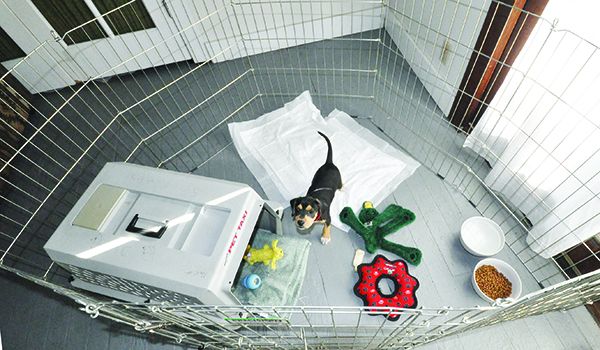
Sooner or later, at some point in your dog’s life, she is probably going to need to be kept confined. There was a time when “confinement” pretty universally meant shutting your dog in a crate just big enough for her to stand up, turn around, and lie down. Times have changed. Welcome to the new world of creative canine containment!
There are many legitimate reasons why your dog might need some degree of confinement. These include:
- Housetraining
- Medical (incontinence, dementia, restricted activity following surgery/injury)
- Management of unwanted behaviors (counter surfing, chewing, getting in garbage, etc.)
- Managing behavioral issues between household companions (dog-dog, dog-cat, dog-bird, etc.)
- Respecting the comfort of non-dog-loving visitors
- Protecting fragile family members (or visitors) from unwanted or overly vigorous attention (seniors, small children)
- Managing aggression/reactivity toward visitors
- Your desire for some quiet time away from your beloved canine pal
CONTAINMENT OPTIONS: ALTERNATIVES FOR INDOOR CAGES FOR DOGS
The crate is still an option, of course. My preferred use for these is now for medical recovery that requires more restriction than other options, for safe travel in vehicles, and for brief periods of confinement and convenience (a quick stash while the workman walks through the house to the backyard). I frequently use a crate for brief moments of confinement for our newest Kelpie, KC, who can bound over a traditional baby gate without batting an eye.
Crates are also frequently used for housetraining. Given that it’s rare for a dog to eliminate in such a small space, the crate is used to confine the dog between frequent trips outside, where the dog is encouraged to eliminate and richly rewarded for doing so. Elimination outdoors earns the dog a brief period of house freedom before she is again contained for a short time in the crate, to await the next outdoor elimination opportunity.
Housetraining aside, you can safely confine your dog using another option for any of the confinement reasons listed above, while giving your dog more freedom and a better quality of life. Consider using one of the following methods or tools:
- A leash
While we tend to think of leashes as a tool with which to take our dogs for a walk, they can also help you keep tabs on your dog in the house, for management of housetraining, counter surfing, and other house manners issues. Clip the leash to your dog’s collar, slip the handle over your wrist, and happily watch TV, check your social media, do your laundry, or sit down to play Parcheesi with the family. Your dog is confined but still with you.
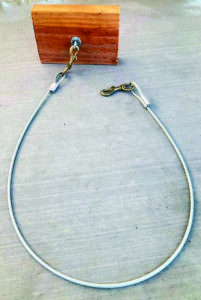
- A tether
This is essentially a leash that attaches the dog to something other than you. Wrap it around the leg of a heavy piece of furniture, run the clip through the leash handle and voilà! A tether!
Given enough time on a tether, however, many dogs will chew through a leash. In this case, purchase a commercial plastic-coated cable tether with clips on both ends – one to clip to your dog’s harness and the other end to fasten to something solid.
Some people don’t mind screwing an eye bolt into a stud in their wall and clipping the end of the tether to the eye bolt. A less home-damaging option is to screw an eye bolt a block of wood, and clip the other end of the tether to the eye bolt. Slide the tether under a door, close the door with the block on the far side, and the door will hold your tethered dog in place.
Pettethers.com is a great commercial source for tethers of various weights and lengths for various sized dogs and different situations; they also offer the block-end tether. If you’re handy (that would be my husband, not me), you can also make your own tethers from plastic-coated cable available at any hardware store.
A few tether cautions:
1. Spend some time helping your dog learn to be comfortable on the tether. Stay close, feed her treats, and only gradually move farther away from your tethered dog.
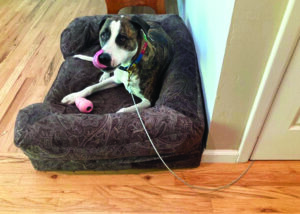
2. Consider giving her a snuffle mat or a Lickimat to keep her content while tethered. Food-stuffed toys such as Kongs or Toppls may be pushed or roll out of the reach of the tethered dog, leading to increased frustration.
3. Never leave your dog unattended when tethered, even if just for a few minutes. Things can happen.
4. We recommend using a harness when you tether, rather than a collar, to avoid injury to your dog’s neck should she jerk on the tether.
For more information about tethering, see “Tethered to Success,” WDJ November 2020.
- Exercise pens
Originally, these useful tools traditionally came in the form of a utilitarian folding fence, usually with six or eight panels. One could clip the ends together to create a wire hexagon, or stretch it across a room or opening (in those open floor-plan homes) to give your dog a larger space.
“Ex pens” come in varying heights, from 24 inches high (useful mostly for young puppies and very small dogs) to 48 inches high; they also come in various weights. Some dogs learn to push the lighter-weight pens across floors or knock them over; the heavier models, made of thicker gauge wire, help prevent this.
Happily, more and more pet-product manufacturers are coming out with freestanding barriers that are both sturdier and more attractive than plain old ex pens. They are made with a variety of materials (wood, plastic, hollow metal tubes, solid metal bars, etc.) and in a variety of finishes to match nearly any décor.
For example, Carlson Pet Products makes a wide variety of pet barriers, including a “Super Wide Pet Gate” which is 10 feet long with flexible hinges that allow for a variety of shaping options. The ends of the fence can be mounted on walls or attached to each other to create a pen. One segment of the fence has a walk-through gate. You can also purchase additional attachments to create any length you want or need. (See carlsonpetproducts.com/gates.)
These barriers are terrific for keeping dogs apart and yet still integrated into the family’s environment. We’ve used them to keep a puppy or pesty adolescent dog from bothering an arthritic old-timer and to prevent canine family members who are prone to squabbling from laying claim to the same sofa or spot by the wood stove.
Here’s another ex-pen option: How about putting the human in the pen? Don’t want your dog jumping on you in your recliner or on your 90-year-old grandmother in her wheelchair? Put your ex-pen around you or grandma!
- Door barriers
If you have an entire room that’s dog-proofed sufficiently for confining your dog, you have several options for doorway barriers. If there are doors to the room, you could just close them, and that may be the wisest choice if you need a visual barrier as well as a physical one. However, that isolates the dog completely, and there are many occasions where it’s helpful to allow your dog some access to household activities so she can habituate to what’s going on. Here are some other door barrier options:
- Baby gates
Again, a long-standing dog-management tool with lots of new options. Carlson Pet Products, mentioned above, also has a wide selection of gates, including retractable, expandable, auto-closing, extra-tall, extra-small, designer, small-dog door built into the gate, pressure-mounted, screw-in, and freestanding, in a variety of materials.
If you have an athletically gifted dog like our KC, you may need to look for an extra tall gate, such as the 72-inch-high Kitty Gate from Roverpet (roverpet.com/dogs_cats/tall-cat-gate/).
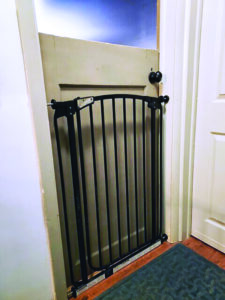
- The Dutch door
In my days at the Marine Humane Society, several of my coworkers and I were fortunate enough to be allowed to bring our dogs to work with us. Our maintenance supervisor “Dutched” all of our office doors so we could keep the top half of the door open with the bottom half closed, and conduct business while keeping our dogs safely contained. You can purchase Dutch doors or “Dutch” your own. If you want to Dutch your own doors, be sure to get solid (not hollow-core) wooden doors!
- Fireplace screen
If you have dogs who are barrier-respectful, you can re-purpose an easily movable decorative fireplace screen to block off a door or stairway.
- Whatever you happen to have handy
Last but not least, a couple of trainer friends shared their “just make do” stories with me. Marnie Montgomery of Joyful Dog LLC in Leesburg, Virginia, said, “My personal favorite was a phalanx of bar stools, which were high enough to prevent jumping over, with spaces between small enough to prevent a mid-sized dog from passing through. Coupled with kitchen ‘islands,’ we found them to be an effective temporary solution.”
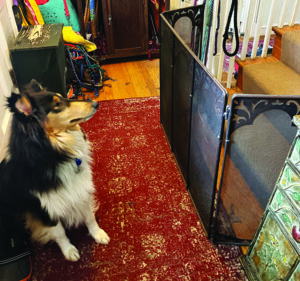
Alexis Bond from Dog Only Knows in Annapolis, Maryland, says, “Whenever I see a used crib free or on the side of the road, I pick up the side rails. I can move them around or double them up for wider spaces. They are easy to block different areas. Obviously for some dogs I may have to find a way to hook them or slide them behind a piece of furniture.”
Jackie Moyano of Behavior United in Wheaton, Maryland, shared, “At an Airbnb in Vermont, I placed a high-backed chair on the deck sideways in order to block off deck access to the unfenced yard. Probably wouldn’t work for all-sized dogs, but it kept my low-rider Dachshund-mix from unauthorized walkabouts.”
IF THE BARRIER FAILS, DOUBLE DOWN
Mature dogs who have been trained to accept confinement will likely go along with whatever arrangements you make for a barrier. However, young dogs who haven’t yet been securely confined might see any barrier that can be moved or scaled as a challenge. Your initial efforts to contain young dogs will be most successful if you use a barrier that can’t be pushed aside or knocked over. Gates and indoor fences that are secured with hardware (rather than pressure-mounted with springs, for example) will help discourage escape attempts.
Use maximally secure barriers for puppies or dogs who are prone to separation anxiety or isolation distress, or dogs who exhibit aggression toward other household members (human, canine, or other). Once a dog has gotten reinforced with freedom by scaling or pushing through a barrier, he’s likely to try extra hard next time he’s confined. Don’t try using the exact same setup the next time you need to confine him, but “go big” with a hardware-mounted, extra-tall gate, for example.
So, be it a leash, a tether, a gate, a door, a pen, whether purchased, found, improvised, or homemade, you have lots of options for keeping your canine companion safely and happily confined.






Great content on how to train our dogs!
I don’t care what anyone says, crates are cruel. For years we have just blocked off the kitchen with a baby gate when we first got a new dog. Then once they are used to the house and (it doesn’t take that long for this to happen) and if the house is baby proofed, they do fine free to roam in the home. Never had a problem. I hope that people will consider what it would be like to be locked in a small box for hours at a time. It must be so terrifying for pets.
If it is so terrifying than why do my dogs still use open door crates to sleep in? That is their comfort space. My current dogs are 5 and 6 years old and have free run of the house, but at night they want to be in their cave.
My 9.5 year old bulldog goes to her crate to go to bed every night and she has free run of the house.
For my foster dogs, sometimes fearful, not house trained, chewers, I have a kennel in the house, not something everyone can do or wants to but I need a place to keep that that is large enough for them to have plenty of room to move around.
Most of them have only gone potty in the kennel once and then hold it overnight. I also need to be gone for 3-4 hours at a time and I need those foster dogs to be safe.
I use crates, with all my dogs at some point, and with all my foster dogs, The smallest crate I use is 40″ long, not a little box.
Great article- loads of very useful tips.
Had to use a crate a few times after surgery etc and when confinement times were complete, the crate stated in place but kept door open and the dogs returned to sleep in the crate during the day & at night so I think it must have given them a sense of security.
I also had a rescued GSD with broken leg who totally hated/feared the crate so it was a very difficult time trying to contain him